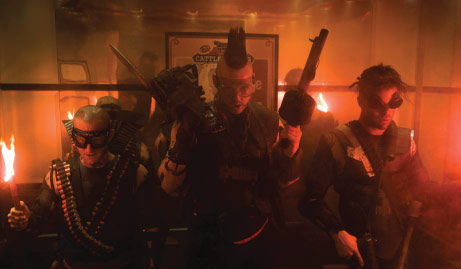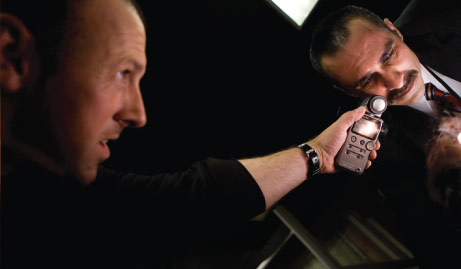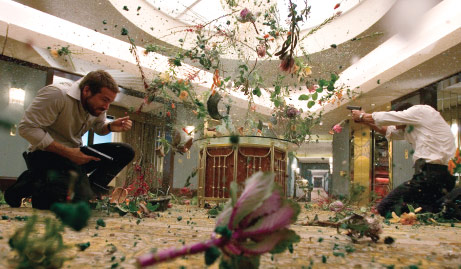 |
 |
 |
 |
 |
|
|
 |
 |
|

|

|

|
FEBRUARY CONTENT:
|
 |
|
 |
SMOKIN' ACES, DP Mauro Fiore, ASC takes aim
By David Geffner
By Pauline Rogers.
PRESIDENT'S LETTER
by Steven Poster, ASC.
THE ASTRONAUT FARMER, DP M. David Mullen, ASC blasts off
By Pauline Rogers
BLACK SNAKE MOAN, DP Amy Vincent, ASC breaks the chain
By Bob Fisher
FRIDAY NIGHT LIGHTS, DP David Boyd, ASC scores
By David Heuring.
|
4K: READY FOR PRIMETIME?
By Sheigh Crabtree
CREW VIEW, Assistant Angelo DiGiacomo
By Bonnie Goldberg
ASC LIFETIME ACHIEVEMENT AWARD WINNERS
By Bob Fisher
THE FILM CREW, HD Expo panel
By Robert Allen
BAND PRO'S ONE WORLD EVENT |
|
 |
 |
 |
|
 |
 |
 |
MAURO FIORE, ASC AND CREW HAVE A BLAST WITH SMOKIN' ACES
By David Geffner
Photos by Jaimie Trueblood |
 |
 |
 |
Some films that appear playful on-screen belie the harsh pressures and tensions that clouded the set; others get the same results with crew members having pinched themselves they were paid to have so much fun. The latter was the case with Joe Carnahan's Smokin' Aces, photographed by Italian-born cinematographer Mauro Fiore, ASC. Alternately described by the Local 600 camera department as “a blast,” “super-fun,” and “wildly creative,” the environment the director (who first came to attention with the low-budget genre-busting flick Blood, Guts, Bullets & Octane) created included a booming sound system where musical requests were instantly downloaded from the Internet, and Carnahan donning period afro wigs and oversized sunglasses to heighten the festive mood. Fiore, who first met Carnahan when the director hired him to lens a short film for BMW, summed up the shoot this way: “It's a lot like going over to your best friend's house for a party every day,” the DP laughs. “Joe's dedicating songs to you in-between takes, and he lets everyone pack into the trailer at the end of the day to watch dailies.” Fiore, whose own moments of creative inspiration on Smokin' Aces, included bouncing lights off a reflective metal doggie dish, says Carnahan evinced zero ego to threaten or inhibit crewmembers. “I liken it to my family's big Italian dinners,” says Fiore. “There's always five conversations going at once and everyone has an opinion about everything. It's crazy, but it's invigorating.”
The production of Smokin' Aces may have been egalitarian bordering on social chaos, but that hardly meant it lacked method. In fact, the film's complex visual storytelling (Jeremy Piven plays a Las Vegas comic who turns state's evidence against the mob and is hunted down by a wildly diverse pack of professional assassins) is so tightly scripted, characters finish each other's sentences from scene-to-scene. Fiore says if the projectionist in your local multiplex misses a reel change by a fraction of a second, key information may go missing. A-camera and Steadicam operator David Emmerichs, who worked with Fiore on Armageddon and The Island, describes shooting days on Smokin' Aces as among the most efficient he'd ever experienced. “You have a director who knows exactly what he wants and moved quickly to the next set-up once he got it [rather than keep shooting safety coverage],” Emmerichs says. “Roughly fifty percent of the movie is handheld. But we didn't do it to save time, or to draw the audience into the scene in a forced way. It was a frantic and insane movie and the handheld was used to capture that [overall] feeling, not to make up for a lack of that type of visual energy.” “What made it such an efficient show,” Fiore continues, “ is the degree to which our prep time was used on the set. Joe and I would discuss scene blocking, camera placement, framing, and lens selection while we scouted each location. We'd spend |
| |
 |
| DP Mauro Fiore, ASC calls Smokin’ Aces one of the most creatively liberating films he’s ever done. |
|
hours on our tech scouts discussing the conceptual meaning behind each scene, so that when the day came there wasn't a need for long conversations.”
In a movie filled with action set pieces that often venture into the realm of visual absurdism, two or three sequences stand out. A-camera First Assistant Larry Nielsen recalls a key scene where one of the contract killers (played by Taraji Henson from Hustle & Flow) sights the movie's prey, Buddy Israel, through the scope of a .50 caliber Barrett rifle. “It starts on Buddy in his penthouse hotel room, tracks across the street to where Taraji has him lined up,” Nielsen explains, “and then dollies back as she fires to follow the path of the bullet. We shot Super 35mm spherical, with A and B Panavision Platinum cameras [B-camera was operated by Maurice McGuire, B-camera First Assistant was David Richert], rather than anamorphic, because we had scenes, like this one, where Mauro needed to get very close. With Super 35mm there wasn't an issue with minimum focus and lens selection.” Nielsen used a macro-focus rig, provided by Panavision, to hone in on Taraji's eyeball looking directly through the rifle's scope. To get the shot's circular motion-the frame travels down the rifle barrel and into an earpiece she's using to mark Israel's location-it was easier to rotate the actress, rather than the camera. “My approach [to pulling focus] is to always hug the film plane,” says Nielsen. “It helps me to judge distance and puts me right next to the operator so I can hear him. Even when Dave was operating the Steadicam I was still up on the film plane right next to him.”
One distinct challenge for Fiore's team was a scene featuring a trio of familial assassins known as the Tremor brothers. In the story, the killers move down a hallway in Buddy Israel's hotel, wiping out any living thing in their path. The most important goal of the scene, according to Fiore, was to capture the motion of the violence in one single direction as the brothers moved forward. Complicating things was Carnahan's desire to shoot at 120fps, which would allow him to pull selected pieces of the sequence. “At one point we were going to take the ceiling off the set and use a Technocrane,” Fiore notes. “But I was adamant about working within the set because it's disruptive to the audience to suddenly have the roof disappear. Our production designer, Martin Whist, built a portion of the hallway to see how much width we would need to follow them in one direction on a dolly. Our gaffer, Mike Bauman, was able to boost the overall ambience using mostly soft instruments from above. It was important for the light on the walls to drop off and pool in the center, to keep with the look we had established for the Tremor brothers. Martin built removable ceiling panels so we could tuck more lights up in the rafters.” Smokin' Aces follows a group of wild characters that all have distinctive visual styles. Ryan Reynolds and Ray Liotta play FBI agents assigned to bring Buddy Israel into the witness protection program. “Instead of fighting the genre style we've seen on all the TV shows about FBI agents,” Fiore explains, “I embraced the look, using long lenses and floating with the dolly when they are observing crime scenes. Taraji and Alicia Keys were basically straight out of black exploitation films,” he laughs. “I emphasized color, used higher key lighting with contrast, and shot mostly handheld to play up that visual genre.” For the mythical Tremor Brothers (who may or may not even be real), Fiore went for a Sergio Leone look, using extreme wide-angles, crisp depth of field, and electric blue skies to play off foreground and background contrast ratios. To visualize Primo Sparazza, who is Buddy Israel's father by adoption, Fiore drew from 1940's-era crime/noir photographers like Weegie, pulling out color (save for some bold red and yellow highlights from clothing and practical lamps) for both the dailies and digital intermediate. The DP used Kodak 5246 (a 250-rated daylight stock that has since gone out of production), which allowed him to filter down exterior scenes and still maintain plenty of contrast. He also used Kodak 5218 (ASA 500, Tungsten), a sensitive stock that provided “beautiful and crisp” night exteriors. However, when Fiore was shooting on the stage, he opted for Kodak 5279 (also rated 500, Tungsten) because it afforded much “cleaner whites” than 5218, according to the DP. “Given that Smokin' Aces had a scene where we had to pump in enough light to shoot at 120 fps, I knew the older stock, the 5279, was the better choice for the stage.” |
| |
 |
| |
The Italian connection (as in the region's many influential schools of painting) was never far removed from Fiore's approach. Rather than pushing light onto a set through a multitude of instruments, the DP kept his package to a minimum and capitalized on production design. Much in the way a Caravaggio or Da Vinci once bounced light off the elements in a still life to create mood and texture, Fiore took full advantage of Martin Whist's bright and lively production design. “Our bounce cards were all keyed to the colors present in each scene,” notes Fiore. “If there was a mirror or painting, we'd use that element to reflect or fill-in light on people's faces. I even threw some Leikos on a reflective metal dog bowl to kick light up through the frame. I had done that in a moment of angst on another movie and my crew never let me forget it, even though it looked great!” Sometimes Fiore and his team got more than they bargained for. An elevator scene highlights the film's extended climax. All the players come together in a Lake Tahoe hotel for a crescendo of violence that is raised to absurdly gory levels. All four walls of the elevator are mirrored, and every other surface is polished brass.
Riding up to Israel's penthouse, Ray Liotta's FBI agent finds himself pitted against the film's most insane mad-dog killer Pasqual Acosta (Nestor Carbonell), a man who has chewed off his fingers to avoid fingerprint detection. The build-up to their battle is done entirely through reflections off the elevator's doors and mirrors: Liotta sees a series of warped mental abstractions, details that in a cop's mind make up the murderer's profile. When a macro-close-up reveals Acosta has no fingerprints, all hell breaks loose. What begins as a relatively realistic sequence (lit from above with Kino Flos rigged inside the railing for an ambient light wash), transforms into an explosion of surreal violence. The men pull their weapons and start shooting (visualized with strobes, Lighting Strikes, and road flares). They set the entire space on fire, bursting the fluorescent bulbs above, which rain down and eventually plunge the elevator into darkness. “It started off as, 'Boy, wouldn't it be nice to have a few mirrors to reflect light off of,” Fiore laughs, “and evolved into a literal cube of reflective glass where you could not hide any instruments, or find a spot to place the camera.”
Emmerichs says the scene (which was inspired by Robert De Niro's final killing spree in Taxi Driver, where each gunshot is methodically played out) was a camera operator's nightmare. Working in a 6-by-6-foot space, there were times when the operator just put on black clothing, because he could not find anywhere to hide where he would not be in the shot. “It was very intense, with squibs, and gunshots going off, and the actors right on top of each other,” he recalls. “Larry had to pull focus remotely from up in the ceiling panel, because it was just so hard to avoid all the reflections.”
Emmerichs, who worked as a focus puller prior to operating, says he has learned from past shows the importance of constant communication with the first AC. “Larry is a fantastic focus puller, and I still stared my eyeballs out trying to make sure everything was sharp,” says Emmerichs. “Between the Steadicam, dolly, handheld, and all the arcing, panning, and spinning we did, the camera was pretty much always moving.”
Another major reason Mauro Fiore chose to shoot Super 35mm was Carnahan's desire to color correct via digital intermediate. The director often employed visual effects to extend the length of live action shots, i.e., following the path of Taraji Henson's bullet right into the hotel room of her prey. Surprisingly, Fiore says not all that much manipulation went on when he and Carnahan hunkered down in the DI suite. The DP insists the look of the film was built-in from dailies, and he and the director mostly just fine-tuned color tonality. “If the light was green, what type of green and did it need more red or yellow?” Fiore relates. “My attitude about the DI is that it's just like visual effects. They're great when they enhance what's going on in reality. When you scatter Power Windows all over a shot, you're suddenly looking at a Photoshop manipulation. It's important to have things burn out and drop off. That's what's great about film: to be able to have the roughness and mistakes as well as the image that's totally polished.” |
| |
 |
| |
| Fiore calls Smokin' Aces one of the most creatively liberating films he's ever done. “Through discussion, chaos, collaboration, and just sheer fun, working with a director like Joe Carnahan is all about maximizing every moment on the set. Our B-camera operator, Maurice McGuire, said it best when he pointed out that the work is almost secondary to the experience. What's unique is that Joe makes sure every crewmember is creatively involved in the process. He solicits ideas from anyone, and that, in turn, brings out the best work from everyone.” Fiore says while the end product may look really free and loose, the partnership (between Carnahan and Fiore) is based on a very traditional and methodical working plan. “Joe gives me complete freedom with the camera, and he hires me to bring as many ideas as I can to the party that will further the storytelling,” the DP concludes. “It's a true collaborative process, which is, unfortunately, becoming rare in Hollywood these days.” David Emmerichs confirms Fiore's thoughts, noting that he's never seen a director arrive on the set with such a pure love for moviemaking. “His energy was infectious and you couldn't wait to go to work each day,” smiles Emmerichs. “I mean, honestly, how many shows do you work on where the director is blasting Social Distortion's version of Ring of Fire to pump up the crew? Or where Darth Vader's Imperial March from Star Wars booms out when the studio executives come to visit the set?” |
|
 |
|
|
 |
|
|
 |